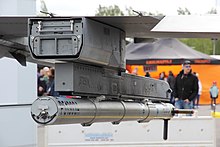
The AN/ALE-50 towed decoy system is an electronic countermeasure tool designed by Raytheon to protect multiple US military aircraft from air-to-air and surface-to-air radar-guided missiles.[1] The AN/ALE-50 towed decoy system is an anti-missile countermeasures decoy system used on U.S. Air Force, Navy, and Marine Corps aircraft, and by certain non-United States air forces. The system is manufactured by Raytheon Space and Airborne Systems at its facility in Goleta, California. The ALE-50 system consists of a launcher and launch controller installed on the aircraft (usually on a wing pylon), and one or more expendable towed decoys. Each decoy is delivered in a sealed canister and has a ten-year shelf life.[2]
When deployed, the decoy is towed behind the host aircraft, protecting the aircraft and its crew against RF-guided missiles by luring the missile toward the decoy and away from the intended target. In both flight tests and actual combat, the ALE-50 has successfully countered numerous live firings of both surface-to-air and air-to-air missiles. U.S. military pilots have nicknamed the decoy "Little Buddy".[3] The system requires no threat-specific software, and communicates its health and status to the aircraft over a standard data bus.[4]